Description
World record size WS2 crystals. We offer the largest size crystals at the highest quality possible. Our WS2 crystals are treated as gold standards in field. These WS2 vdW crystals are grown using two different techniques, namely chemical vapor transport (CVT) and Flux zone growth (Flux) to achieve impressive WSe2 characteristics. We offer guaranteed excitonic, PL, and electronic properties.
Flux grown: WS2 crystals will exhibit superior electronic, valleytronic performance with perfect crystallization, defect free structure, extremely narrow PL bandwidths, clean PL spectra (free of bound exciton shoulders), and high carrier mobility.
CVT grown: These samples will be more comparable to other commercially available materials with some defects and lower electronic/optical quality but at slightly larger sizes.
Status: In stock
![]() Materials Project WS2
Materials Project WS2
![]() C2DB material properties WS2
C2DB material properties WS2
20 years of growth optimization in chemical vapor transport (CVT) as well as flux growth lead to our flawless WS2 crystals: The only commercial WS2 crystals that come with guaranteed valleytronic and PL responses.
Typical characteristics of WS2 crystals from 2Dsemiconductors
| Crystal Size | ~1cm in size |
| Dopants | Undoped (intrinsic semiconductor), Please also see our n- and p-type WS2 crystals doped with Au, Re, Nb, or other transition metal atoms. |
| Material properties | 2.02 eV emission (300k), direct gap semiconductor |
| Crystal structure | Hexagonal phase |
| Unit cell perameters | a = b = 0.317 nm, c - 1.230 nm, α=β=90°, y=120° |
| Growth methods | Flux zone (no halide contamination) defect free. CVT, contains Br₂, Cl₂, TeCl₄ and other halides |
| Purity | 99.9999% confirmed |
Growth method matters> Flux zone or CVT growth method? Contamination of halides and point defects in layered crystals are well known cause for their reduced electronic mobility, reduced anisotropic response, poor e-h recombination, low-PL emission, and lower optical absorption. Flux zone technique is a halide free technique used for synthesizing truly semiconductor grade vdW crystals. This method distinguishes itself from chemical vapor transport (CVT) technique in the following regard: CVT is a quick (~2 weeks) growth method but exhibits poor crystalline quality and the defect concentration reaches to 1E11 to 1E12 cm-2 range. In contrast, flux method takes long (~3 months) growth time, but ensures slow crystallization for perfect atomic structuring, and impurity free crystal growth with defect concentration as low as 1E9 - 1E10 cm-2. During check out just state which type of growth process is preferred. Unless otherwise stated, 2Dsemiconductors ships Flux zone crystals as a default choice.
http://meetings.aps.org/Meeting/MAR18/Session/K36.3
http://meetings.aps.org/Meeting/MAR17/Session/V1.14
XRD data collected from WS2 crystals
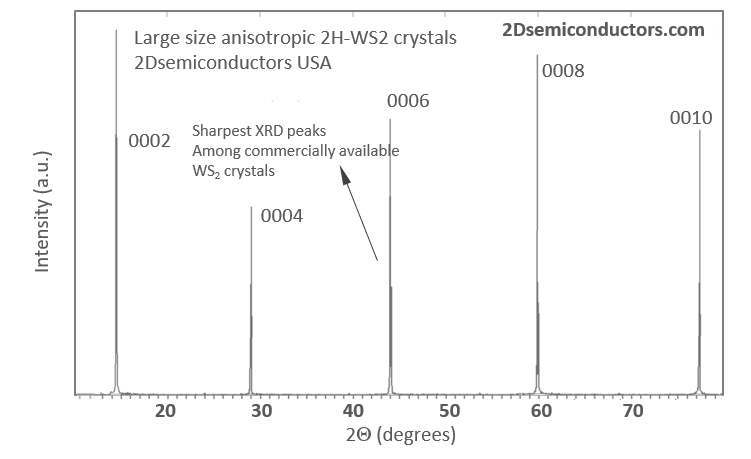
Raman spectrum collected from WS2 monolayers
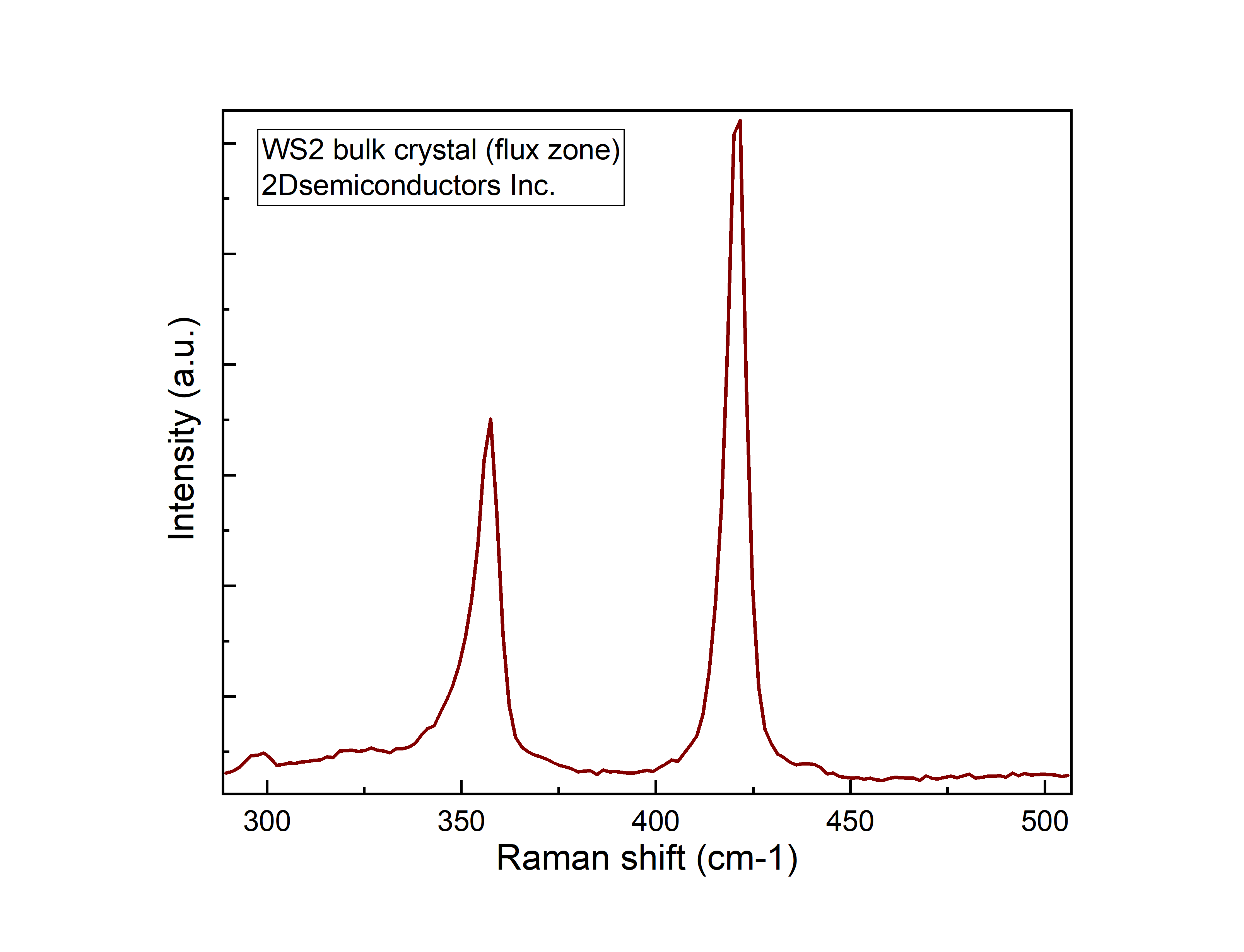
PL spectrum collected from monolayer WS2 on SiO2/Si substrates
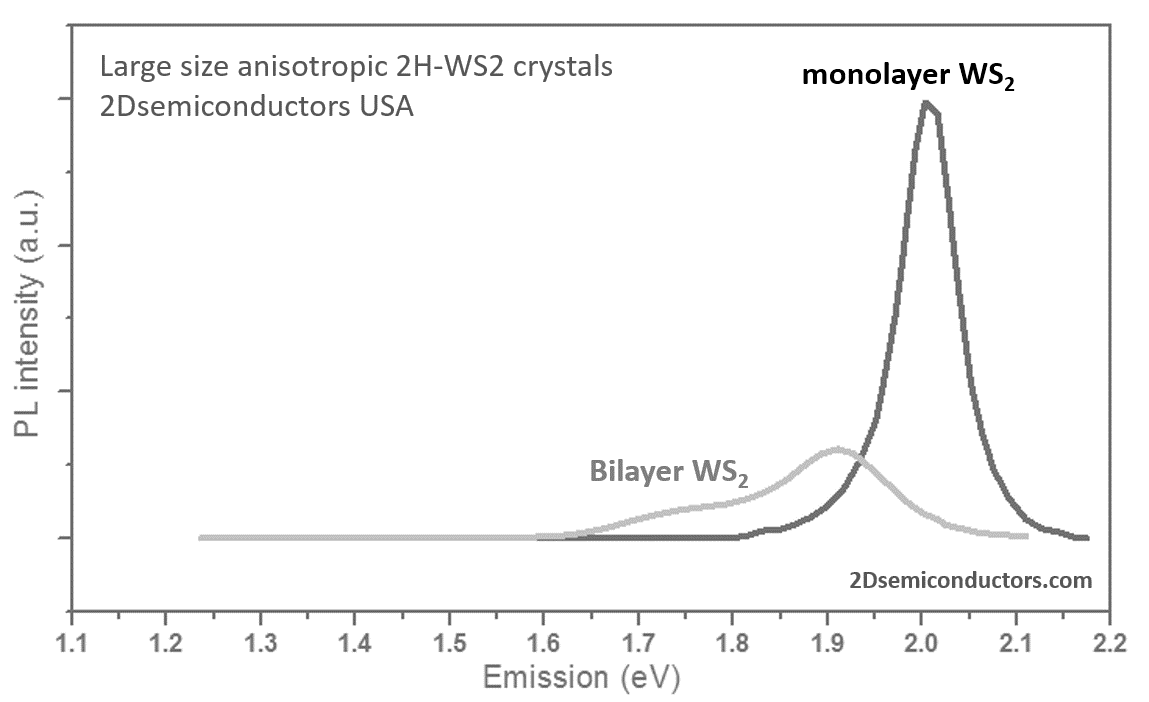
SIMS purity datasets collected from WS2 crystals
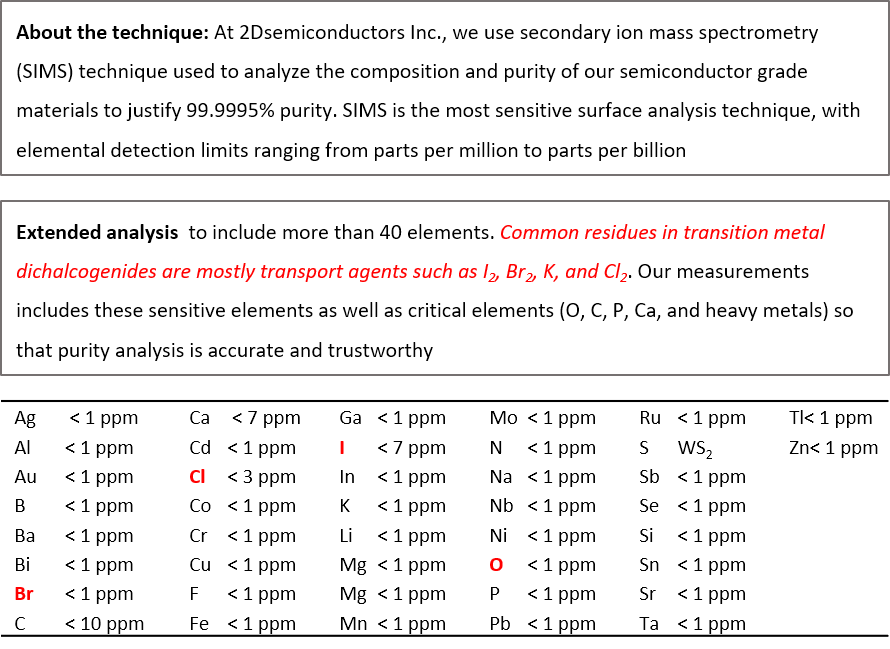
HRTEM images collected from WS2 crystals
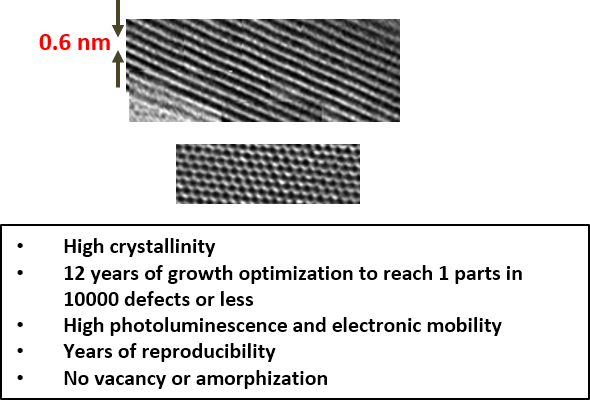
Partial List of Published Articles from This Product
Summary: Publications from MIT, Washington, MIT, Berkeley, Stanford, and Princeton teams at top journals like Nature Nanotechnology, Nano Letters, and Advanced Materials
Spontaneous Polarity Flipping in a 2D Heterobilayer Induced by Fluctuating Interfacial Carrier Flows
Nano Lett. , 21, 16, 6773–6780 (2021)
Spin/valley pumping of resident electrons in WSe2 and WS2 monolayers
Nature Communications volume 12, Article number: 5455 (2021)
Control of Exciton Valley Coherence in Transition Metal Dichalcogenide Monolayers, Phys. Rev. Lett. 117, 187401 (2016)
T. Scrace et. al. "Magnetoluminescence and valley polarized state of a two-dimensional electron gas in WS2 monolayers" Nature Nanotechnology 10, 603–607 (2015) doi:10.1038/nnano.2015.78
J. He et. al. "Electron transfer and coupling in graphene–tungsten disulfide van der Waals heterostructures" Nature Communications 5, Article number: 5622 (2014)
Measurement of the optical dielectric function of monolayer transition-metal dichalcogenides: MoS2, MoSe2, WS2, and WSe2, Yilei Li, Alexey Chernikov, Xian Zhang, Albert Rigosi, Heather M. Hill, Arend M. van der Zande, Daniel A. Chenet, En-Min Shih, James Hone, and Tony F. Heinz; Phys. Rev. B 90, 205422 (2014)
UT Austin - A. P. Nayak et. al. "Pressure-Modulated Conductivity, carrier Density, and Mobility of Multilayered Tungsten Disulfide" ACS Nano 10.1021/acsnano.5b03295
N. Peimyoo et. al. Nonblinking, Intense Two-Dimensional Light Emitter: Monolayer WS2 Triangles ACS Nano, 2013, 7 (12), pp 10985–10994
Manish Chhowalla, "Two-dimensional semiconductors for transistors" Nature Reviews Materials 1, Article number: 16052 (2016) doi:10.1038/natrevmats.2016.52
Tongay et. al. "Defects activated photoluminescence in two-dimensional semiconductors: interplay between bound, charged, and free excitons" Scientific Reports 3, Article number: 2657 (2013)
X Li et al. "Determining layer number of twodimensional flakes of transition-metal dichalcogenides by the Raman intensity from substrates" Nanotechnology 27 (2016) 145704
L. Zhang. et.al. "Photonic-crystal exciton-polaritons in monolayer semiconductors" Nature Communications volume 9, Article number: 713 (2018)
S. Feng et.al. Tunable excitonic emission of monolayer WS2 for the optical detection of DNA nucleobases; Nano Research 2018, 11(3): 1744–1754
"Observation of Excitonic Fine Structure in a 2D Transition-Metal Dichalcogenide Semiconductor" ACS Nano, 2015, 9 (1), pp 647–655
Enhancement of Exciton–Phonon Scattering from Monolayer to Bilayer WS2; Nano Lett., 2018, 18 (10), pp 6135–6143
Additional Information
Elements: |
W,S |
Element: |
Tungsten |
Element: |
Sulfur |
Formula: |
WS2 |
Material class: |
MX2 |
Material class: |
Dichalcogen |
Properties: |
Semiconductor |
Properties: |
Excitonic |
Band gap range: |
VIS |
Growth method: |
CVT |
Growth method: |
Flux |
Doping: |
Undoped |
Doping: |
p-Type |
Doping: |
n-Type |



















